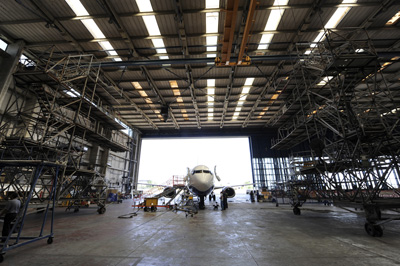 Currently, the Middle Eastern commercial aviation MRO market is growing at a faster rate than the global average. According to ICF International, it is expected to account for up to 8% of the global civil aviation MRO market in 2015. However, as more and more local carriers find having suppliers from North America or Europe no longer acceptable, it is still unclear whether the domestic ones will be able to fully replace them.
Currently, the Middle Eastern commercial aviation MRO market is growing at a faster rate than the global average. According to ICF International, it is expected to account for up to 8% of the global civil aviation MRO market in 2015. However, as more and more local carriers find having suppliers from North America or Europe no longer acceptable, it is still unclear whether the domestic ones will be able to fully replace them.
As Middle Eastern airlines continue to grow their fleets and expand their markets, ICF International predicts the regional MRO market to generate up to $4.6 billion in expenditures in 2015. Moreover, growing at an average of 6.7% annually, the market is expected to reach $8.8 billion in a decade. Following such growth, lately it has been becoming more and more apparent that many carriers want their aftermarket services to come from the region.
For instance, currently four major carriers from the region – Emirates, Qatar, Etihad Airways and Saudia – account for about 67% (about $3 billion) of Middle Eastern MRO expenses. They all have in-house maintenance capabilities, which helps explain why 76% of heavy airframe MRO is done within the region. Moreover, Air Algerie, EgyptAir, Emirates, Kuwait Airways, Middle East Airlines, Qatar Airways and Saudia recently signed a memorandum of understanding to cooperate in such areas as maintenance training, vendor audits, line maintenance and the joint purchase of consumable parts. The collaboration is expected to save the participating airlines about $150 million in the next four years, as well as help gain more efficiency. On the one hand, this does mean that the opportunity for third-party suppliers targeting the MRO segment in the Middle East is becoming increasingly smaller. On the other hand, some experts say there are reasons to believe the carriers’ in-house MRO capabilities might be overestimated.
“The Middle Eastern in-house MRO providers can sure be expected to grow as airlines do. However, at the time they continue to face some specific challenges. For instance, attracting and  retaining technical talent has consistently been a challenge for the region. Meanwhile, it is predicted that the Middle Eastern MRO market will require over 11 million maintenance man-hours to support its growth by 2024,” says Aldas Juronis, the Head of FL Technics Components and Materials Sales Department. “Comprehensive spare parts solutions are also among the services that are still in need of appropriate development, as obtaining the needed spares quickly – especially in AOG situations – continues to be among the reoccurring issues of the local carriers.”
retaining technical talent has consistently been a challenge for the region. Meanwhile, it is predicted that the Middle Eastern MRO market will require over 11 million maintenance man-hours to support its growth by 2024,” says Aldas Juronis, the Head of FL Technics Components and Materials Sales Department. “Comprehensive spare parts solutions are also among the services that are still in need of appropriate development, as obtaining the needed spares quickly – especially in AOG situations – continues to be among the reoccurring issues of the local carriers.”
Aviation Week forecasts that of $4.6 billion the Middle Eastern operators are expected to spend on MRO in 2015, 22% will account for various component supply-related services. Not surprisingly, while talks of switching to local suppliers have been becoming more and more active, some of the third-party players have actually been adding capacity within the region, preparing for the anticipated demand. For instance, one of the other large independent MROs in the region claims it is already handling 65 000 annual transactions and is expected to almost double the number over the next five years.
“Of course, locating aftermarket providers in the Middle East and North Africa should decrease the expenses of shipping MRO work outside the region, as well as costs associated with logistics and longer asset downtime. However, whether the region can ensure an equally speedy development of the region's MRO business still remains to be seen. In the meantime, cooperating with reliable partners from relatively close regions in ensuring continuous supply of spares, as well as gaining crucial technical experience in handling MRO operations, might become a viable strategy in the process of getting off the costly support needle,” concludes Aldas Juronis, the Head of FL Technics Components and Materials Sales Department.





